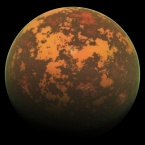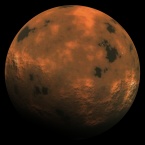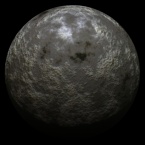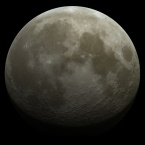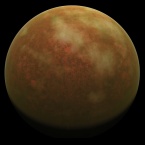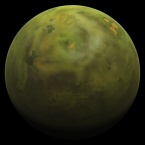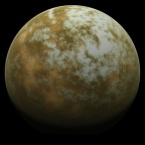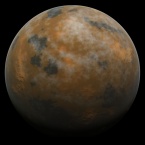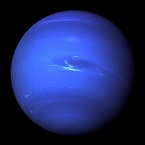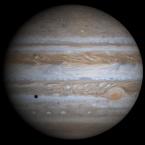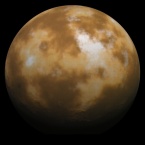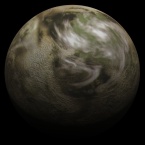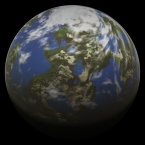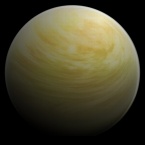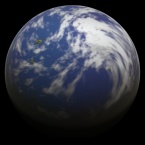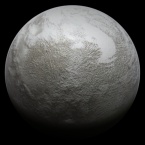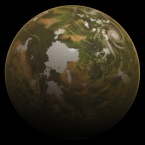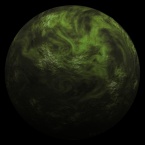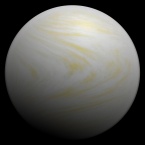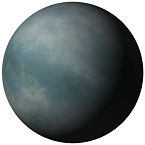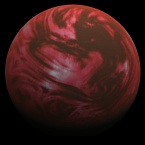Difference between revisions of "Planet Classification"
Teylasramar (talk | contribs) |
Teylasramar (talk | contribs) |
||
| (15 intermediate revisions by the same user not shown) | |||
| Line 1: | Line 1: | ||
{{Icons|bfc}} | {{Icons|bfc}} | ||
=Classifications= | =Classifications= | ||
==Class A - Geothermal== | |||
{| | {| | ||
|- | |-style=width:33% | ||
|[[ | |[[File:Classa.jpg|alt=|left]] | ||
| | | | ||
'''Age:''' 0 - 2 billion years<br> | |||
'''Diameter:''' 1,000 - 10,000 km<br> | |||
'''Location:''' Ecosphere/Cold Zone<br> | |||
'''Surface:''' Partially molten<br> | |||
'''Atmosphere:''' Primarily hydrogen compounds<br> | |||
'''Evolution:''' Cools to become Class C<br> | |||
'''Life Forms:''' None<br> | |||
'''Example:''' [[ma:Gothos|Gothos]] | |||
|} | |||
{| colspan="2" | |||
|Class A geoactive planets are generally small, barren worlds rife with volcanic activity. This activity traps carbon dioxide in the atmosphere, causing a greenhouse effect that keeps the temperature very hot, regardless of the planet's distance from the sun. When the volcanic activity eventually ceases, the planet 'dies' and usually becomes a Class C world - a few rare cases transform into Class Q geothermal planets. Until that happens, the toxic levels of carbon dioxide make this planet unsuitable to any known life form, though silicon-based life may be able to terraform it to their needs. | |Class A geoactive planets are generally small, barren worlds rife with volcanic activity. This activity traps carbon dioxide in the atmosphere, causing a greenhouse effect that keeps the temperature very hot, regardless of the planet's distance from the sun. When the volcanic activity eventually ceases, the planet 'dies' and usually becomes a Class C world - a few rare cases transform into Class Q geothermal planets. Until that happens, the toxic levels of carbon dioxide make this planet unsuitable to any known life form, though silicon-based life may be able to terraform it to their needs. | ||
| | |} | ||
'''Diameter:''' 1,000 - 10,000 km | == Class B - Geomorteus == | ||
{| | |||
|-style=width:33% | |||
|[[File:Classb.jpg|alt=|left]] | |||
| | |||
'''Age:''' 0 - 10 billion years<br> | |||
'''Diameter:''' 1,000 - 10,000 km<br> | |||
'''Location:''' Hot Zone<br> | |||
'''Surface:''' Partially molten, high surface temperatures<br> | |||
'''Atmosphere:''' Extremely tenuous, few chemically active gasses<br> | |||
'''Evolution:''' None<br> | |||
'''Life Forms:''' None<br> | |||
'''Example:''' [[ma:Mercury|Mercury]] | |||
|} | |||
{| colspan="2" | |||
|Class B planets are small, mostly metallic rocky planetoids. This type of planet is usually very close to, and heated by, a parent star, featuring very little native geothermal energy. The atmosphere of these worlds is usually tenuous and features little or no chemically active particles. No lifeforms have ever been discovered on these planets. Due to the proximity to their star's destructive influence of most other materials, Class B worlds exhibit a highly iron-rich crust, with a magnetic core and no mantle. | |||
|} | |||
'''Location:''' Ecosphere/Cold Zone | ==Class C - Geoinactive== | ||
{| | |||
|-style=width:33% | |||
|[[File:Classc.jpg|alt=|left]] | |||
| | |||
'''Age:''' 2 - 10 billion years<br> | |||
'''Diameter:''' 1,000 - 10,000 km<br> | |||
'''Location:''' Ecosphere/Cold Zone<br> | |||
'''Surface:''' Low surface temperature<br> | |||
'''Atmosphere:''' Frozen<br> | |||
'''Evolution:''' None<br> | |||
'''Life Forms:''' None<br> | |||
'''Example:''' [[ma:Psi_2000|Psi 2000]] | |||
|} | |||
{| colspan="2" | |||
|Class C worlds are a type of planet usually in the very late stages of development that has likely evolved from another class. Essentially dead, these small, rocky worlds are generally geothermally inactive and have a cold, barren surface. As their core cooled down, their rotation slowed and eventually their atmosphere dissipated. No life form as any use for these planets, although they do often possess rich mineral deposits from their volcanically-active past. | |||
|} | |||
==Class D - Dwarf Planetoids== | |||
{| | |||
|-style=width:33% | |||
|[[File:Classd.jpg|alt=|left]] | |||
| | | | ||
'''Atmosphere:''' | '''Age:''' 2 - 10 billion years<br> | ||
'''Diameter:''' 100 - 1,000 km<br> | |||
'''Location:''' Hot Zone/Ecosphere/Cold Zone; found primarily in orbit of larger planets or in asteroid fields/belts<br> | |||
'''Surface:''' Barren and cratered<br> | |||
'''Atmosphere:''' None or very tenuous<br> | |||
'''Evolution:''' None<br> | |||
'''Life Forms:''' None<br> | |||
'''Example:''' [[ma:Luna|Luna]], [[wikipedia:Ceres_(dwarf_planet)|Ceres]] | |||
|} | |||
{| colspan="2" | |||
|Class D planetoids are generally smaller asteroids or moons that are locked into the gravitational pull of a larger planetary body. Class D worlds are barren and rocky, often possessing no atmosphere usually composed of metals, predominantly nickel, iron, and silicate. Animal life is unable to form on D class planetoids. Depending on their proximity to a star, a D class may be hot and arid or cold and frozen. These planets can be made habitable by terraforming as was the case with Weytahn by the Andorians during the 2050s. | |||
|} | |||
'''Evolution:''' Cools to become Class | == Class E - Geoplastic== | ||
{| | |||
|-style=width:33% | |||
|[[File:Classe.jpg|alt=|left]] | |||
| | |||
'''Age:''' 0 - 2 billion years<br> | |||
'''Diameter:''' 10,000 - 15,000 km<br> | |||
'''Location:'''Ecosphere<br> | |||
'''Surface:''' Molten, high temperature<br> | |||
'''Atmosphere:''' Hydrogen compounds and reactive gases<br> | |||
'''Evolution:''' Cools to become Class F<br> | |||
'''Life Forms:''' Carbon-cycle<br> | |||
'''Example:''' [[ma:Excalbia|Excalbia]] | |||
|} | |||
{| colspan="2" | |||
|Class E, or Primordial, planets represent the earliest stage in the evolution of a habitable planet. The core and crust is completely molten, making the planets susceptible to solar winds and radiation and subject to extremely high surface temperatures. The atmosphere is very thin, composed of hydrogen and helium. | |||
|} | |||
'''Life Forms:''' | == Class F - Geometallic== | ||
{| | |||
|-style=width:33% | |||
|[[File:Classf.jpg|alt=|left]] | |||
| | |||
'''Age:''' 1 - 2 billion years<br> | |||
'''Diameter:''' 10,000 - 15,000 km<br> | |||
'''Location:'''Ecosphere<br> | |||
'''Surface:''' Volcanic eruptions due to molten core<br> | |||
'''Atmosphere:''' Hydrogen compounds<br> | |||
'''Evolution:''' Surface cools to become Class G<br> | |||
'''Life Forms:''' Primitive organic bacteria<br> | |||
'''Example:''' [[ma:Janus_VI|Janus VI]] | |||
|} | |||
{| colspan="2" | |||
|Class F, or Developing, planets derive from the cooling and hardening of the crust in a Class E planet. Possesses a primarily silicate-based crust, although vulcanism is still rife. Water has begun to condense to form oceans, amid centuries of constant rainfall. The atmosphere and the life that may develop on the surface are intertwined; as the rich carbon dioxide atmosphere allows early photosynthetic life to flourish, these organisms flood the atmosphere with oxygen, pushing towards the next stage in its evolution. | |||
|} | |||
==Class G - Geocrystalline== | |||
|- | {| | ||
|[[ | |-style=width:33% | ||
|[[File:Classg.jpg|alt=|left]] | |||
| | | | ||
==Class | '''Age:''' 3 - 4 billion years<br> | ||
|- | '''Diameter:''' 10,000 - 15,000 km<br> | ||
'''Location:'''Ecosphere<br> | |||
'''Surface:''' Rocky, mostly barren<br> | |||
'''Atmosphere:''' Carbon dioxide, oxygen, nitrogen<br> | |||
'''Evolution:''' Cools to Class H, K, L, M, N O, P<br> | |||
'''Life Forms:''' Vegetation, simple organisms<br> | |||
'''Example:''' [[ma:Delta_Vega|Delta Vega]] | |||
|} | |||
{| colspan="2" | |||
|Class G, or Primitive, planets derive from a Class F planet as its surface cools, volcanic activity lessens, and oxygen and nitrogen are more abundant in the atmosphere. The atmosphere is still primarily carbon dioxide released as the planet cools and crystallizes. Primitive vegetation like algae and simple animal lifeforms like sponges are able to take hold in oceans to supplement the planet's bacterial life. This is the most important step in the formation of most planets as multiple complex factors determine what class of planet will evolve next. | |||
|} | |||
==Class H - Desert== | |||
{| | |||
|-style=width:33% | |||
|[[File:Classh.jpg|alt=|left]] | |||
| | | | ||
| | '''Age:''' 4 - 10 billion years<br> | ||
'''Diameter:''' 8,000 - 15,000 km<br> | |||
'''Location:''' Hot Zone / Ecosphere / Cold Zone<br> | |||
'''Surface:''' Hot and arid, little or no surface water<br> | |||
'''Atmosphere:''' May contain heavy gases and metal vapors<br> | |||
'''Evolution:''' None<br> | |||
'''Life Forms:''' Drought- and radiation-resistant plants, animal life<br> | |||
'''Example:''' [[ma:Nimbus_III|Nimbus III]], [[ma:Ocampa|Ocampa]] | |||
|} | |||
{| colspan="2" | |||
|Rocky planets with primarily silicate crusts, Class H planets are true desert worlds. With less than 20% of its surface covered in surface water and high levels of surface radiation, Class H planets are not conducive to complex ecosystems. Though many Class H worlds are covered in sand, it is not required to be considered a desert; it must, however, receive little in the way of precipitation. Drought-resistant plants and animals are common on Class H worlds, and many are inhabited by humanoid populations. Most Class H worlds are hot and arid, but conditions can vary greatly. Class M planets can be reduced to Class H through environmental damage. | |||
|} | |||
==Class I - Ice Giant == | |||
|- | {| | ||
|[[ | |-style=width:33% | ||
|[[File:Classi.jpg|alt=|left]] | |||
| | | | ||
== | '''Age:''' 2 - 10 billion years<br> | ||
|- | '''Diameter:''' 30,000 - 100,000 km<br> | ||
'''Location:''' Cold Zone<br> | |||
'''Surface:''' Rocky, with methane and ammonia ice<br> | |||
'''Atmosphere:''' Hydrogen, helium, methane, ammonia, water<br> | |||
'''Evolution:''' None<br> | |||
'''Life Forms:''' None<br> | |||
'''Example:''' [[ma:Uranus|Uranus]], [[ma:Neptune|Neptune]] | |||
|} | |||
{| colspan="2" | |||
|Class I, or Uranian, planets are gaseous giants that have vastly different compositions from other giant worlds; the core is mostly rock and ice made of methane, water, and ammonia. Additionally, the magnetic field is sharply inclined to the axis of rotation. Unlike other gas giants, Class I planets almost exclusively form on the outer fringes of a young star system. | |||
|} | |||
==Class J - Gas Giant== | |||
{| | |||
|-style=width:33% | |||
|[[File:Classj.jpg|alt=|left]] | |||
| | |||
'''Age:''' 2 - 10 billion years<br> | |||
'''Diameter:''' 50,000 - 140,000 km<br> | |||
'''Location:''' Cold Zone<br> | |||
'''Surface:''' Tenuous, composed of gaseous hydrogen and hydrogen compounds; radiates some heat<br> | |||
'''Atmosphere:''' Zones vary in temperature, pressure and composition<br> | |||
'''Evolution:''' None<br> | |||
'''Life Forms:''' Hydrocarbon based<br> | |||
'''Example:''' [[ma:Jupiter|Jupiter]], [[ma:Saturn|Saturn]] | |||
|} | |||
{| colspan="2" | |||
|Class J, or Jovian, planets are massive spheres of liquid and gaseous hydrogen, with small cores of metallic hydrogen. Their atmospheres are extremely turbulent, with wind speeds in the most severe storms reaching 600 kph. Many Class J planets also possess impressive ring systems, composed primarily of rock, dust, and ice, as well as many moons, some of which are often habitable. They form in the Cold Zone of a star system, though typically much closer than Class I planets. | |||
|} | |||
==Class K - Adaptable == | |||
{| | |||
|-style=width:33% | |||
|[[File:Classk.jpg|alt=|left]] | |||
| | |||
'''Age:''' 4 - 10 billion years<br> | |||
'''Diameter:''' 5,000 - 10,000 km<br> | |||
'''Location:''' Ecosphere<br> | |||
'''Surface:''' Barren, little surface water<br> | |||
'''Atmosphere:''' Thin, mostly carbon dioxide<br> | |||
'''Evolution:''' Class L if extensively terraformed<br> | |||
'''Life Forms:''' Primitive single-cell organisms<br> | |||
'''Example:''' [[ma:Mars|Mars]], [[ma:Mudd|Mudd]] | |||
|} | |||
{| colspan="2" | |||
|Class K planets are essentially dead terrestrial planets, with a primarily silicate crust, rich mineral deposits, and no magnetic field. The atmosphere is thin, predominantly carbon dioxide, and retains little heat, leading to a frigid desert landscape. Nonetheless, there can be some weather systems in a Class K atmosphere, and vulcanism can occur. Water and/or carbon dioxide ice may be found at the poles. Class K surfaces are barren, often cold, and cannot support animal life as there is commonly no liquid water or too little to sustain vegetation. Class K environments can develop from the evolution of Class G, or through the long deterioration of classes G, L or M. Their weak magnetic fields allow large quantities of solar radiation to reach the surface and heat to escape back into space. Colonization is possible by the use of pressure domes or monumental terraforming efforts. | |||
|} | |||
==Class L - Marginal== | |||
{| | |||
|-style=width:33% | |||
|[[File:Classl.jpg|alt=|left]] | |||
| | | | ||
| | '''Age:''' 4 - 10 billion years<br> | ||
'''Diameter:''' 10,000 - 15,000 km<br> | |||
'''Location:''' Ecosphere<br> | |||
'''Surface:''' Rocky and barren, little surface water<br> | |||
'''Atmosphere:''' Oxygen / argon, high concentration of carbon dioxide<br> | |||
'''Evolution:''' Class M with limited terraforming<br> | |||
'''Life Forms:''' Limited to vegetation<br> | |||
'''Example:''' [[ma:Mars|Mars]], [[ma:Mudd|Mudd]] | |||
|} | |||
{| colspan="2" | |||
|Similar to Class M planets, Class L planets are on the borderline of life-bearing environments. Typically rocky, silicate-crust planets, Class L worlds are commonly arid, but in some cases display oceans or tundra. Surface temperature varies considerably, and the atmosphere is thinner than on a Class M world, with high levels of argon, carbon dioxide, and often other toxic gases. Radiation levels are potentially dangerous. Class L environments may feature basic ecosystems, normally only with plant life. They may, however, be colonized by humanoid life, and are excellent targets for terraforming. | |||
|} | |||
==Class M - Terrestrial== | |||
|- | {| | ||
|[[ | |-style=width:33% | ||
|[[File:Classm.jpg|alt=|left]] | |||
| | | | ||
== | '''Age:''' 3 - 10 billion years<br> | ||
|- | '''Diameter:''' 10,000 - 15,000 km<br> | ||
'''Location:''' Ecosphere<br> | |||
'''Surface:''' Water abundant<br> | |||
'''Atmosphere:''' Nitrogen, oxygen, trace elements<br> | |||
'''Evolution:''' None<br> | |||
'''Life Forms:''' Extensive vegetation, animal life, humanoids<br> | |||
'''Example:''' [[ma:Earth|Earth]], [[ma:Bajor|Bajor]], [[ma:Cardassia|Cardassia]] | |||
|} | |||
{| colspan="2" | |||
|Class M, or Minshara-class, planets are the most stable type for most humanoid habitation. To be considered Class M, between 20% and 80% of the surface must be covered in water; it must have a breathable oxygen-nitrogen atmosphere and temperate climate. With silicate crusts, those with rotating iron cores can display strong magnetic fields. Rich nitrogen-oxygen atmospheres with some carbon dioxide, water vapor, and trace gases are ideal for the development of varied, complex biospheres. Class M planets feature high surface and atmospheric water content, essential for organic life. Surface conditions can vary considerably across the globe, from tundra, to temperate, to desert environments. Class M worlds can vary widely in visual appearance. Class M is divided into subtypes dependent on surface water levels and other features, and these can vary over the course of a planet's lifespan. | |||
|} | |||
==Class N - Reducing == | |||
{| | |||
|-style=width:33% | |||
|[[File:Classn.jpg|alt=|left]] | |||
| | | | ||
'''Age:''' 3 - 10 billion years<br> | |||
'''Diameter:''' 10,000 - 15,000 km<br> | |||
'''Location:''' Ecosphere<br> | |||
'''Surface:''' High temperature due to greenhouse effect; water exists as vapor<br> | |||
'''Atmosphere:''' Extremely dense, carbon dioxide and sulfides<br> | |||
'''Evolution:''' Class M through extensive terrforming<br> | |||
'''Life Forms:''' Rare; microbial organisms may exist in cloud layer.<br> | |||
'''Example:''' [[ma:Venus|Venus]], [[ma:Tholia|Tholia]], [[ma:Essof_IV|Essof IV]] | |||
|} | |||
{| colspan="2" | |||
|Although similar to Class M planets in size and geological make-up, Class N planets are rendered as hugely different environments due to their atmospheric conditions. A thick carbon dioxide atmosphere causes a runaway greenhouse effect leading to extremely high surface temperature and pressure, utterly inimical to humanoid life. Some nitrogen, water, and sulfur dioxide exist in the atmosphere, which is dominated by clouds of sulphuric acid, leading to corrosive rainfall. A Class N world may potentially be adapted to class-M by long-term terraforming, but this is a significant undertaking and such planets are usually overlooked in favor of more hospitable worlds. | |||
A variation of the Class N planet exists in which a considerably thinner atmosphere, composed mainly of sulfur dioxide and monoxide, sodium chloride vapors, and molecular oxygen. Large deposits of sulfur exist on the surface giving a yellow-green color from orbit. Temperature is lower than N1 conditions, but still high in comparison to Class M, with significant vulcanism caused by gravitational effects from the host planet or star, or by an unstable core. Unlike standard Class N worlds, these environments may develop complex organic life, although such organisms will rely on sulfur respiration and use hydrogen sulfide as a biological solvent in place of water. This life form type is far rarer than the more common oxygen/water type organisms. | |||
Yet another variation of the Class N world exists and is still highly dangerous for organic life forms. Displaying variable surface temperatures and pressures, these atmospheres are predominantly carbon monoxide, laced with corrosive and reactive chemicals such as sodium perchlorate, rapidly toxic to oxygen-breathing life. However, they are also rich in useful chemicals such as deuterium and can be used for small habitats using pressure domes. | |||
|} | |||
==Class O - Pelagic== | |||
|- | {| | ||
|[[ | |-style=width:33% | ||
|[[File:Classo.jpg|alt=|left]] | |||
| | | | ||
'''Age:''' 3 - 10 billion years<br> | |||
| | '''Diameter:''' 10,000 - 15,000 km<br> | ||
| | '''Location:''' Ecosphere<br> | ||
| | '''Surface:''' 80%+ water, archipelagos<br> | ||
'''Atmosphere:''' Nitrogen, oxygen, trace elements<br> | |||
'''Evolution:''' None<br> | |||
'''Life Forms:''' Extensive cetacean, humanoid, animal<br> | |||
'''Example:''' [[ma:Bolarus_IX|Bolarus]], [[ma:Azati_Prime|Azati Prime]], [[ma:Cardassia|Cardassia]] | |||
|} | |||
{| colspan="2" | |||
|Class O planets are any planets with more than 80% of the surface covered in water. These worlds are usually very warm and possess vast cetacean populations in addition to tropical vegetation and animal life. Though rare, humanoid populations have also formed on Class O planets. True ocean worlds with no surface land area. Oceans on Class O planets are typically thousands of kilometers deep, with phenomenal pressures at the depths. Turbulent atmospheres of nitrogen, oxygen, water vapor, and carbon dioxide envelop the planet. | |||
|} | |||
==Class P - Glaciated== | |||
|- | {| | ||
|[[ | |-style=width:33% | ||
|[[File:Classp.jpg|alt=|left]] | |||
| | | | ||
'''Age:''' 3 - 10 billion years<br> | |||
| | '''Diameter:''' 10,000 - 15,000 km<br> | ||
| | '''Location:''' Ecosphere<br> | ||
| | '''Surface:''' 80%+ frozen water, cold<br> | ||
'''Atmosphere:''' Nitrogen, oxygen, trace elements<br> | |||
'''Evolution:''' None<br> | |||
'''Life Forms:''' Vegetation, humanoid, animal<br> | |||
'''Example:''' [[ma:Andoria|Andoria]], [[ma:Breen_(planet)|Breen]] | |||
|} | |||
{| colspan="2" | |||
|Class P planets are any planet whose surface is more than 80% frozen. These glaciated worlds are typically very cold, with temperatures rarely exceeding the freezing point. Though not prime conditions for life, hearty plants and animals are not uncommon, and some species, such as the Aenar and the Andorians, have evolved on Class P worlds. In rare instances, Class P planets can also be based around methane and hydrocarbons, rather than water, such as Breen. | |||
|} | |||
== Class Q - Variable== | |||
|- | {| | ||
|[[ | |-style=width:33% | ||
|[[File:Classq.jpg|alt=|left]] | |||
| | | | ||
'''Age:''' 2 - 10 billion years<br> | |||
| | '''Diameter:''' 4,000 - 15,000 km<br> | ||
| | '''Location:''' Hot Zone / Ecosphere / Cold Zone<br> | ||
| | '''Surface:''' Ranges from molten to water and/or carbon dioxide ice, due to eccentric orbit or variable output of star<br> | ||
'''Atmosphere:''' Ranges from tenuous to very dense<br> | |||
'''Evolution:''' None<br> | |||
'''Life Forms:''' Highly variable<br> | |||
'''Example:''' [[ma:Genesis_(planet)|Genesis]] | |||
|} | |||
{| colspan="2" | |||
|Class Q, or Quaris class, planets are a type of planet that has rarely been encountered by the Federation. Conditions vary widely on class Q worlds, with very hot and cold regions and great variety in surface conditions. These rare planetoids typically develop with a highly eccentric orbit, or near stars with a variable output. As such, conditions on the planet's surface are widely varied. Deserts and rain forests exist within a few kilometers of each other, while glaciers can simultaneously lie very near the equator. Given the constant instability, is virtually impossible for life to exist on Class Q worlds. | |||
|} | |||
==Class R - Rogue== | |||
|- | {| | ||
|[[ | |-style=width:33% | ||
|[[File:Classr.jpg|alt=|left]] | |||
| | | | ||
'''Age:''' 2 - 10 billion years<br> | |||
| | '''Diameter:''' 4,000 - 15,000 km<br> | ||
| | '''Location:''' Interstellar space, cometary halos<br> | ||
| | '''Surface:''' May be temperate due to geothermal venting<br> | ||
'''Atmosphere:''' Primarily volcanic outgassing<br> | |||
'''Evolution:''' None<br> | |||
'''Life Forms:''' Varies from none to complex; non-photosynthetic plants, animal life<br> | |||
'''Example:''' [[ma:Dakala|Dakala]], [[ma:Omarion_Nebula|Omarion]] | |||
|} | |||
{| colspan="2" | |||
|Class R planets usually form within a star system, but at some point in its evolution, the planet is expelled, likely the result of a catastrophic asteroid impact. The shift radically changes the planet's evolution; many planets merely die, but geologically active planets can sustain a habitable surface via volcanic outgassing and geothermal venting. | |||
|} | |||
==Class S - Supergiant== | |||
|- | {| | ||
|[[ | |-style=width:33% | ||
|[[File:Classs.png|alt=|left]] | |||
| | | | ||
'''Age:''' 2 - 10 billion years<br> | |||
| | '''Diameter:''' 10 - 50 billion km<br> | ||
| | '''Location:''' Cold Zone<br> | ||
| | '''Surface:''' Tenuous, composed of gaseous hydrogen and hydrogen compounds; radiates considerable heat<br> | ||
'''Atmosphere:''' Zones vary in temperature and composition; water vapor may be present<br> | |||
'''Evolution:''' None<br> | |||
'''Life Forms:''' None<br> | |||
'''Example:''' [[wikipedia:51_Pegasi_b|Dimidium]], [[wikipedia:55_Cancri_b|55 Cancri b]] | |||
|} | |||
{| colspan="2" | |||
|Class S supergiants are very similar to their Class J counterparts, with liquid metallic hydrogen cores surrounded by a hydrogen and helium atmosphere, aside from their immense size. | |||
|} | |||
==Class T - Ultragiant== | |||
|- | {| | ||
|[[ | |-style=width:33% | ||
|[[File:Classst.jpg|alt=|left]] | |||
| | | | ||
'''Age:''' 2 - 10 billion years<br> | |||
| | '''Diameter:''' 50 - 120 billion km<br> | ||
| | '''Location:''' Cold Zone<br> | ||
| | '''Surface:''' Tenuous, composed of gaseous hydrogen and hydrogen compounds; radiates considerable heat<br> | ||
'''Atmosphere:''' Zones vary in temperature and composition; water vapor may be present<br> | |||
'''Evolution:''' None<br> | |||
'''Life Forms:''' None<br> | |||
'''Example:''' [[wikipedia:Kappa_Andromedae_b|Kappa Andromedae b]] | |||
|} | |||
{| colspan="2" | |||
|Class T planets are gigantic gaseous planets with thick hydrogen atmospheres and enormous gravitational pull, these planets are on the verge of becoming stars. Most exist within a star system's Cold Zone and are very similar to Class S and J planets. If they are sufficiently massive (13 times more massive than Jupiter), deuterium ignites nuclear fusion within the core, and the planet becomes a brown dwarf star, creating a binary star system. | |||
|} | |||
== Class V - Superterrestrial== | |||
|- | {| | ||
|[[ | |-style=width:33% | ||
|[[File:ClassV.png|alt=|left]] | |||
| | | | ||
'''Age:''' 2 - 10 billion years<br> | |||
|- | '''Diameter:''' 20,000 - 70,000 km<br> | ||
| | '''Location:''' Ecosphere<br> | ||
| | '''Surface:''' Water abundant<br> | ||
'''Atmosphere:''' Nitrogen, oxygen, trace elements<br> | |||
'''Evolution:''' None<br> | |||
'''Life Forms:''' Extensive vegetation, animal life<br> | |||
'''Example:''' [[wikipedia:Gliese_163_c|Gliese 163 c]], [[wikipedia:Kepler-22b|Kepler-22b]] | |||
|} | |||
{| colspan="2" | |||
|Class V, or Superearths, are large rocky/metallic planets intermediate in size between terrestrial and ice giants. Their higher gravity allows them to retain dense, hydrogen-rich atmospheres. Surface temperature and pressure are typically high and unsuitable for humanoid habitation, but complex high-temperature life can evolve, and they are potentially viable for colonization using pressure domes. | |||
|} | |||
==Class Y - Demon == | |||
|- | {| | ||
|-style=width:33% | |||
|[[File:Classy.jpg|alt=|left]] | |||
| | | | ||
'''Age:''' 2 - 10 billion years<br> | |||
'''Diameter:''' 10,000 - 15,000 km<br> | |||
'''Location:''' Hot Zone / Ecosphere / Cold Zone<br> | |||
'''Surface:''' Temperature can exceed 500K<br> | |||
'''Atmosphere:''' Turbulent, saturated with toxic chemicals and thermionic radiation<br> | |||
'''Evolution:''' None<br> | |||
'''Life Forms:''' Exceedingly rare, but mimetic life is possible<br> | |||
'''Example:''' [[memoryalpha:Medusan_homeworld|Visalayan]], [[memoryalpha:Ha'Dara|Ha'Dara]] | |||
|} | |||
{| colspan="2" | |||
|Class Y planets are perhaps the most environmentally unfriendly planets in the galaxy and are toxic to known life in every way imaginable. The atmosphere is saturated with toxic radiation, temperatures are extreme, and atmospheric storms are amongst the most severe in the galaxy, with winds in excess of 500 kph. | |||
|} | |} | ||
=Credits= | =Credits= | ||
Descriptions | Descriptions and icons were created using sources including Star Trek Star Charts, [http://danieltessier.blogspot.com/2017/07/star-trek-planetary-classification-guide.html Star Trek Planetary Classification Guide], [http://www.startrekmap.com/library/objects/planetclass.html Star Trek Map Stellar Library], and [https://uss-theurgy.com/w/index.php?title=Planetary_Classification the USS Theurgy Planetary Classification]. | ||
Latest revision as of 16:37, 6 January 2024
Classifications
Class A - Geothermal
|
Age: 0 - 2 billion years |
| Class A geoactive planets are generally small, barren worlds rife with volcanic activity. This activity traps carbon dioxide in the atmosphere, causing a greenhouse effect that keeps the temperature very hot, regardless of the planet's distance from the sun. When the volcanic activity eventually ceases, the planet 'dies' and usually becomes a Class C world - a few rare cases transform into Class Q geothermal planets. Until that happens, the toxic levels of carbon dioxide make this planet unsuitable to any known life form, though silicon-based life may be able to terraform it to their needs. |
Class B - Geomorteus
|
Age: 0 - 10 billion years |
| Class B planets are small, mostly metallic rocky planetoids. This type of planet is usually very close to, and heated by, a parent star, featuring very little native geothermal energy. The atmosphere of these worlds is usually tenuous and features little or no chemically active particles. No lifeforms have ever been discovered on these planets. Due to the proximity to their star's destructive influence of most other materials, Class B worlds exhibit a highly iron-rich crust, with a magnetic core and no mantle. |
Class C - Geoinactive
|
Age: 2 - 10 billion years |
| Class C worlds are a type of planet usually in the very late stages of development that has likely evolved from another class. Essentially dead, these small, rocky worlds are generally geothermally inactive and have a cold, barren surface. As their core cooled down, their rotation slowed and eventually their atmosphere dissipated. No life form as any use for these planets, although they do often possess rich mineral deposits from their volcanically-active past. |
Class D - Dwarf Planetoids
|
Age: 2 - 10 billion years |
| Class D planetoids are generally smaller asteroids or moons that are locked into the gravitational pull of a larger planetary body. Class D worlds are barren and rocky, often possessing no atmosphere usually composed of metals, predominantly nickel, iron, and silicate. Animal life is unable to form on D class planetoids. Depending on their proximity to a star, a D class may be hot and arid or cold and frozen. These planets can be made habitable by terraforming as was the case with Weytahn by the Andorians during the 2050s. |
Class E - Geoplastic
|
Age: 0 - 2 billion years |
| Class E, or Primordial, planets represent the earliest stage in the evolution of a habitable planet. The core and crust is completely molten, making the planets susceptible to solar winds and radiation and subject to extremely high surface temperatures. The atmosphere is very thin, composed of hydrogen and helium. |
Class F - Geometallic
|
Age: 1 - 2 billion years |
| Class F, or Developing, planets derive from the cooling and hardening of the crust in a Class E planet. Possesses a primarily silicate-based crust, although vulcanism is still rife. Water has begun to condense to form oceans, amid centuries of constant rainfall. The atmosphere and the life that may develop on the surface are intertwined; as the rich carbon dioxide atmosphere allows early photosynthetic life to flourish, these organisms flood the atmosphere with oxygen, pushing towards the next stage in its evolution. |
Class G - Geocrystalline
|
Age: 3 - 4 billion years |
| Class G, or Primitive, planets derive from a Class F planet as its surface cools, volcanic activity lessens, and oxygen and nitrogen are more abundant in the atmosphere. The atmosphere is still primarily carbon dioxide released as the planet cools and crystallizes. Primitive vegetation like algae and simple animal lifeforms like sponges are able to take hold in oceans to supplement the planet's bacterial life. This is the most important step in the formation of most planets as multiple complex factors determine what class of planet will evolve next. |
Class H - Desert
|
Age: 4 - 10 billion years |
| Rocky planets with primarily silicate crusts, Class H planets are true desert worlds. With less than 20% of its surface covered in surface water and high levels of surface radiation, Class H planets are not conducive to complex ecosystems. Though many Class H worlds are covered in sand, it is not required to be considered a desert; it must, however, receive little in the way of precipitation. Drought-resistant plants and animals are common on Class H worlds, and many are inhabited by humanoid populations. Most Class H worlds are hot and arid, but conditions can vary greatly. Class M planets can be reduced to Class H through environmental damage. |
Class I - Ice Giant
|
Age: 2 - 10 billion years |
| Class I, or Uranian, planets are gaseous giants that have vastly different compositions from other giant worlds; the core is mostly rock and ice made of methane, water, and ammonia. Additionally, the magnetic field is sharply inclined to the axis of rotation. Unlike other gas giants, Class I planets almost exclusively form on the outer fringes of a young star system. |
Class J - Gas Giant
|
Age: 2 - 10 billion years |
| Class J, or Jovian, planets are massive spheres of liquid and gaseous hydrogen, with small cores of metallic hydrogen. Their atmospheres are extremely turbulent, with wind speeds in the most severe storms reaching 600 kph. Many Class J planets also possess impressive ring systems, composed primarily of rock, dust, and ice, as well as many moons, some of which are often habitable. They form in the Cold Zone of a star system, though typically much closer than Class I planets. |
Class K - Adaptable
|
Age: 4 - 10 billion years |
| Class K planets are essentially dead terrestrial planets, with a primarily silicate crust, rich mineral deposits, and no magnetic field. The atmosphere is thin, predominantly carbon dioxide, and retains little heat, leading to a frigid desert landscape. Nonetheless, there can be some weather systems in a Class K atmosphere, and vulcanism can occur. Water and/or carbon dioxide ice may be found at the poles. Class K surfaces are barren, often cold, and cannot support animal life as there is commonly no liquid water or too little to sustain vegetation. Class K environments can develop from the evolution of Class G, or through the long deterioration of classes G, L or M. Their weak magnetic fields allow large quantities of solar radiation to reach the surface and heat to escape back into space. Colonization is possible by the use of pressure domes or monumental terraforming efforts. |
Class L - Marginal
|
Age: 4 - 10 billion years |
| Similar to Class M planets, Class L planets are on the borderline of life-bearing environments. Typically rocky, silicate-crust planets, Class L worlds are commonly arid, but in some cases display oceans or tundra. Surface temperature varies considerably, and the atmosphere is thinner than on a Class M world, with high levels of argon, carbon dioxide, and often other toxic gases. Radiation levels are potentially dangerous. Class L environments may feature basic ecosystems, normally only with plant life. They may, however, be colonized by humanoid life, and are excellent targets for terraforming. |
Class M - Terrestrial
|
Age: 3 - 10 billion years |
| Class M, or Minshara-class, planets are the most stable type for most humanoid habitation. To be considered Class M, between 20% and 80% of the surface must be covered in water; it must have a breathable oxygen-nitrogen atmosphere and temperate climate. With silicate crusts, those with rotating iron cores can display strong magnetic fields. Rich nitrogen-oxygen atmospheres with some carbon dioxide, water vapor, and trace gases are ideal for the development of varied, complex biospheres. Class M planets feature high surface and atmospheric water content, essential for organic life. Surface conditions can vary considerably across the globe, from tundra, to temperate, to desert environments. Class M worlds can vary widely in visual appearance. Class M is divided into subtypes dependent on surface water levels and other features, and these can vary over the course of a planet's lifespan. |
Class N - Reducing
|
Age: 3 - 10 billion years |
| Although similar to Class M planets in size and geological make-up, Class N planets are rendered as hugely different environments due to their atmospheric conditions. A thick carbon dioxide atmosphere causes a runaway greenhouse effect leading to extremely high surface temperature and pressure, utterly inimical to humanoid life. Some nitrogen, water, and sulfur dioxide exist in the atmosphere, which is dominated by clouds of sulphuric acid, leading to corrosive rainfall. A Class N world may potentially be adapted to class-M by long-term terraforming, but this is a significant undertaking and such planets are usually overlooked in favor of more hospitable worlds.
A variation of the Class N planet exists in which a considerably thinner atmosphere, composed mainly of sulfur dioxide and monoxide, sodium chloride vapors, and molecular oxygen. Large deposits of sulfur exist on the surface giving a yellow-green color from orbit. Temperature is lower than N1 conditions, but still high in comparison to Class M, with significant vulcanism caused by gravitational effects from the host planet or star, or by an unstable core. Unlike standard Class N worlds, these environments may develop complex organic life, although such organisms will rely on sulfur respiration and use hydrogen sulfide as a biological solvent in place of water. This life form type is far rarer than the more common oxygen/water type organisms. Yet another variation of the Class N world exists and is still highly dangerous for organic life forms. Displaying variable surface temperatures and pressures, these atmospheres are predominantly carbon monoxide, laced with corrosive and reactive chemicals such as sodium perchlorate, rapidly toxic to oxygen-breathing life. However, they are also rich in useful chemicals such as deuterium and can be used for small habitats using pressure domes. |
Class O - Pelagic
|
Age: 3 - 10 billion years |
| Class O planets are any planets with more than 80% of the surface covered in water. These worlds are usually very warm and possess vast cetacean populations in addition to tropical vegetation and animal life. Though rare, humanoid populations have also formed on Class O planets. True ocean worlds with no surface land area. Oceans on Class O planets are typically thousands of kilometers deep, with phenomenal pressures at the depths. Turbulent atmospheres of nitrogen, oxygen, water vapor, and carbon dioxide envelop the planet. |
Class P - Glaciated
|
Age: 3 - 10 billion years |
| Class P planets are any planet whose surface is more than 80% frozen. These glaciated worlds are typically very cold, with temperatures rarely exceeding the freezing point. Though not prime conditions for life, hearty plants and animals are not uncommon, and some species, such as the Aenar and the Andorians, have evolved on Class P worlds. In rare instances, Class P planets can also be based around methane and hydrocarbons, rather than water, such as Breen. |
Class Q - Variable
|
Age: 2 - 10 billion years |
| Class Q, or Quaris class, planets are a type of planet that has rarely been encountered by the Federation. Conditions vary widely on class Q worlds, with very hot and cold regions and great variety in surface conditions. These rare planetoids typically develop with a highly eccentric orbit, or near stars with a variable output. As such, conditions on the planet's surface are widely varied. Deserts and rain forests exist within a few kilometers of each other, while glaciers can simultaneously lie very near the equator. Given the constant instability, is virtually impossible for life to exist on Class Q worlds. |
Class R - Rogue
|
Age: 2 - 10 billion years |
| Class R planets usually form within a star system, but at some point in its evolution, the planet is expelled, likely the result of a catastrophic asteroid impact. The shift radically changes the planet's evolution; many planets merely die, but geologically active planets can sustain a habitable surface via volcanic outgassing and geothermal venting. |
Class S - Supergiant
|
Age: 2 - 10 billion years |
| Class S supergiants are very similar to their Class J counterparts, with liquid metallic hydrogen cores surrounded by a hydrogen and helium atmosphere, aside from their immense size. |
Class T - Ultragiant
|
Age: 2 - 10 billion years |
| Class T planets are gigantic gaseous planets with thick hydrogen atmospheres and enormous gravitational pull, these planets are on the verge of becoming stars. Most exist within a star system's Cold Zone and are very similar to Class S and J planets. If they are sufficiently massive (13 times more massive than Jupiter), deuterium ignites nuclear fusion within the core, and the planet becomes a brown dwarf star, creating a binary star system. |
Class V - Superterrestrial
|
Age: 2 - 10 billion years |
| Class V, or Superearths, are large rocky/metallic planets intermediate in size between terrestrial and ice giants. Their higher gravity allows them to retain dense, hydrogen-rich atmospheres. Surface temperature and pressure are typically high and unsuitable for humanoid habitation, but complex high-temperature life can evolve, and they are potentially viable for colonization using pressure domes. |
Class Y - Demon
|
Age: 2 - 10 billion years |
| Class Y planets are perhaps the most environmentally unfriendly planets in the galaxy and are toxic to known life in every way imaginable. The atmosphere is saturated with toxic radiation, temperatures are extreme, and atmospheric storms are amongst the most severe in the galaxy, with winds in excess of 500 kph. |
Credits
Descriptions and icons were created using sources including Star Trek Star Charts, Star Trek Planetary Classification Guide, Star Trek Map Stellar Library, and the USS Theurgy Planetary Classification.
